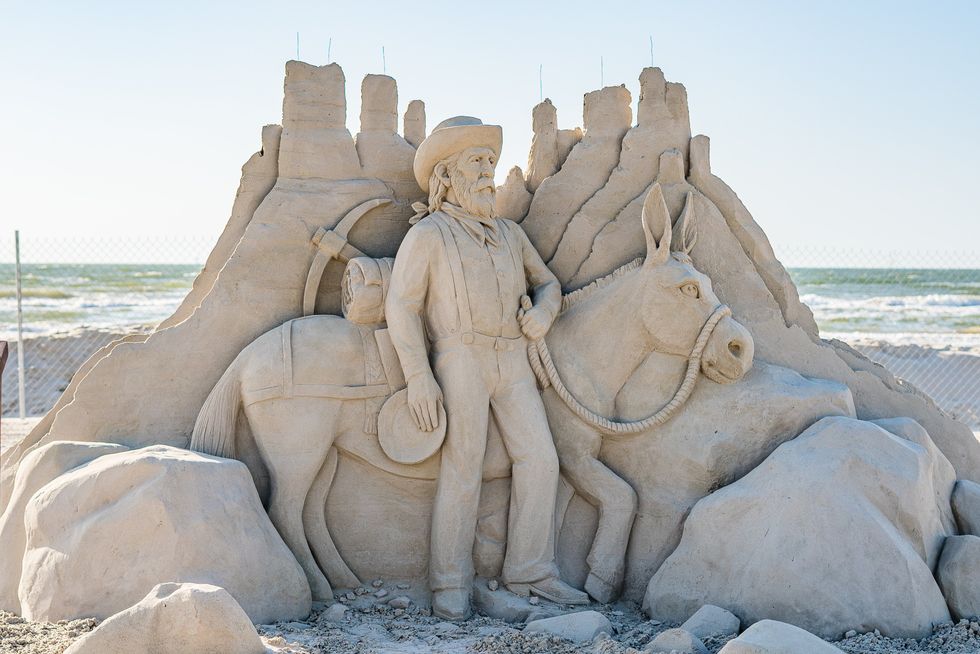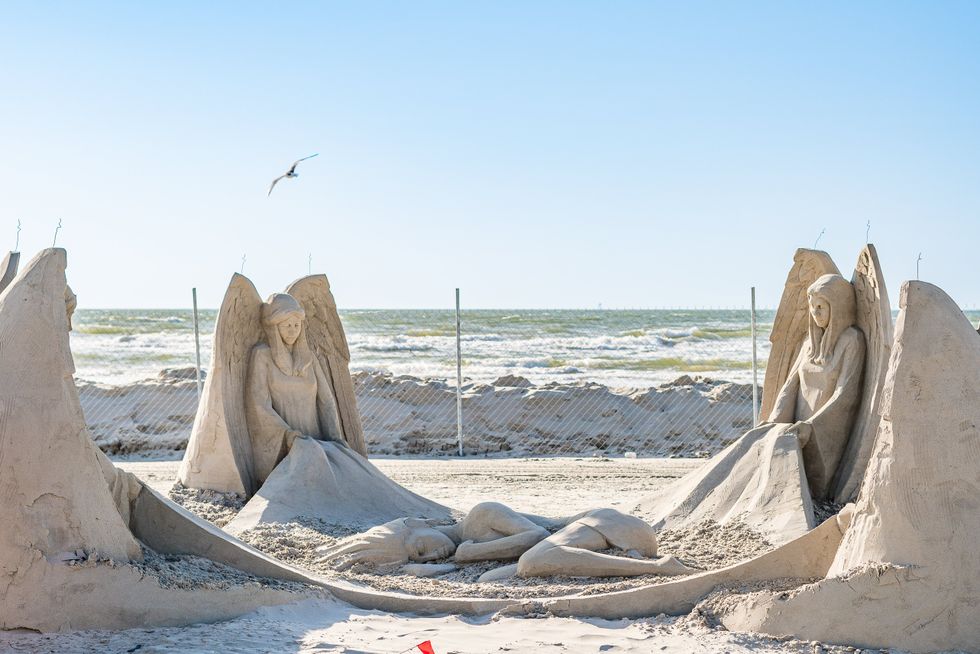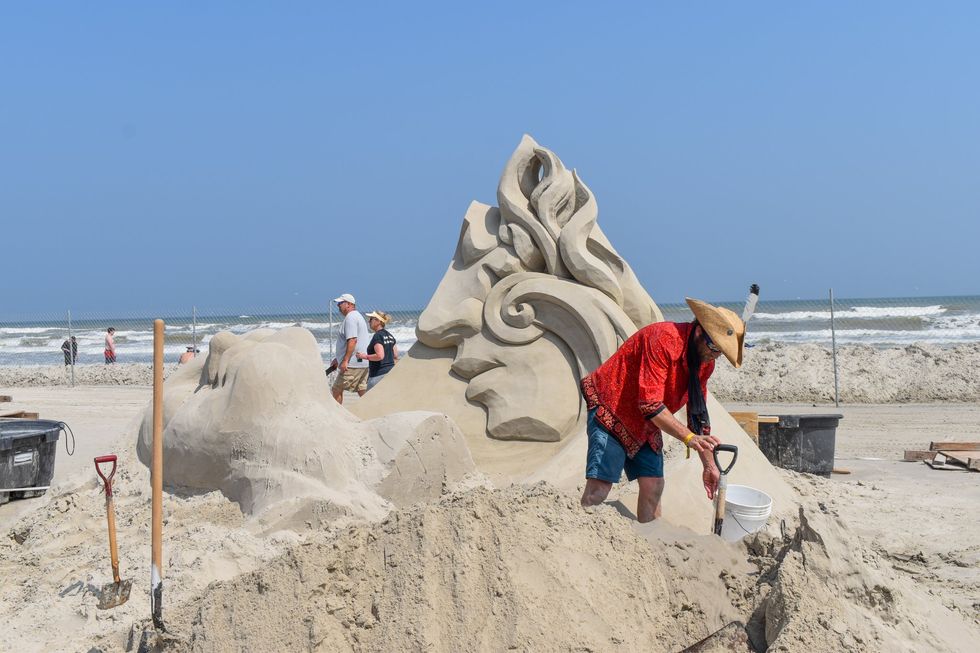Vacation mode
5 tips for stunning beach sand sculptures from 2023 Texas SandFest winners
As summer fast approaches, sandy vacations to coastal destinations are on the horizon for many travelers. For those with kids in tow, sandcastle-making might top the list of beach trip must-dos.
But “playing” in the sand isn’t just an activity for children, as proven by the 22 professional sand sculptors from around the world who recently competed in the 26th annual Texas SandFest, held in Port Aransas in April. The internationally recognized event, started by Port A locals in 1997, is the largest native-sand sculptor competition in the nation; nearly 70,000 people attended this year.
Competition entries featured everything from mermaids to the Grim Reaper, all intricately carved, brushed, and chiseled from sand, ocean water, and perhaps a little diluted spray glue that sculptors say helps maintain detail. The competitors work on their masterpieces during the event, allowing spectators to witness their progress from start to finish.
“I do around five international sand sculpting competitions per year. It’s always a great challenge to compete a high level,” says Benoit Dutherage, a competitive sculptor from France who also creates snow sculptures in the French Alps during the winter.
Dutherage took first place in the Duo Masters category, along with his sand sculpting partner Sue McGrew, for their work called “Wish You Were Here.” Comprised of two loving faces (one mystically cut in half), the sculpture was a tribute to Pink Floyd.
“We like to reflect human emotions in our sculptures,” he says. “It is never easy to pick an idea among the thousands of ideas we have.”
Florida resident Thomas Koet, whose sculpture called “The Prospector” won first place in the People’s Choice category, intended to create something with horses and a cowboy as an homage to Mustang Island, where the competition took place. High tides just before the event thwarted his plans.
“The high tide washed away so much of the sand, I had only enough left for a mule or a foal,” he says. “So I decided to make an old prospector with a mule.”
Thinking out of the box when it comes to carving sand is just one of several suggestions Koet has for recreational sand sculptors. (“Who says it has to be a castle?” he says.) He and other winners from the 2023 Texas SandFest say they are always happy to see novices get creative.
Here are five of the pros' top tips for producing a beachfront masterpiece.
1. Think beyond the standard sandcastle
“Design and sculpt outside of your comfort zone,” says Abe Waterman, a sculptor from Prince Edward Island, Canada, who took first place in the Solo Masters division with his sculpture, “Sleeps with Angels.” The mega sculpture featured four angels at four corners holding a blanket carrying a sleeping woman. “While this may not lead to the best sculpture results, one will improve faster by doing this.”
Waterman noted that there are different types of sand depending on location. Some are better suited for detailed work while others work well for verticality. “But something can always be sculpted regardless of the sand quality, the design just may need to be altered,” he says.
Koet recommends picking something that will fit your attention span. “You can make anything you want,” he says. “You can make a cat, a shark, a monster truck, your high school mascot, a sneaker, or a shark eating an ice cream cone.”
2. Use the right tools
Forgo the cheap tourist shop plastic bucket and shovel set. “You definitely need proper tools to get a good result: A solid shovel, a few trowels – not too big – and a wall painting brush to clean your sculpture,” says Dutherage. “You’ll also need buckets.”
Think big painter’s buckets, he says, used to make what’s essentially “sand mud” consisting of lots of water and sand. Which leads to the next tip ...
3. Create a form mold
Consider this the secret to head-turning sand sculptures. Whether it’s a 10-foot-tall wooden box with sides that come off, or a plastic bucket with the bottom cut out, a “form mold” is an open-top vessel used to hold packed sand and water to create a carve-able structure.
“It’s a very useful thing to have in order to get a solid block, and to go high,” says Dutherage. “If you are a handyman, you can build your own forms. But a quick solution is to take a bucket, no matter what size, and cut out the bottom. Then put that bucket upside down on the sand. Add a few inches of sand, some water, mix with your trowel and compact that layer. Repeat until the bucket is full. Then gently pull the bucket up and surprise! You will get a nice block of sand ready for a sandcastle full of windows, arches, and gates.”
The compacted layers of sand and water almost act as cement, creating a sturdy base for carving. Dutherage says folks can easily repeat the form mold process to create multiple bases, either side by side or stacked.
4. Use plenty of water, for the sculpture and yourself
Benoit recommends adding even more water during the sculpting process.
“Bring a plant sprayer,” he says. “Sand needs to be wet to be sculptable.”
Even rain during sand sculpture building isn’t necessarily a bad thing. “One of the biggest misconceptions is that rain will destroy a sand sculpture,” says Waterman. “While this is possible, most often it just textures the surface.”
Water is also essential for the sculptor, as staying hydrated is key during the process, Waterman adds.
5. Practice, Practice, Practice
“The biggest misconception is that I do anything different than anybody who does it only for the first time,” says Koet, who’s been sculpting sand for 25 years. “Sure, I bring more and bigger tools and I spend much more time shoveling the sand high and mixing it with water. But there is no magic other than years of practice.”
Waterman, who admits sand sculpting has taken over his life, competes in up to 10 contests a year and also creates sculptures for exhibits and corporate commissions.
“Tricks and tips will only get a person so far,” he says. “But ultimately practice and putting the time in will get them a whole lot further.”
Benoit agrees. “Making a sand sculpture requires a lot of work and the more you practice, the better you will get,” he says. “But first of all, you have to enjoy the fun of it.”






